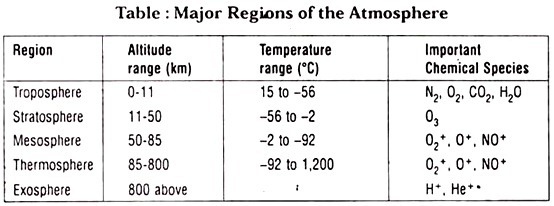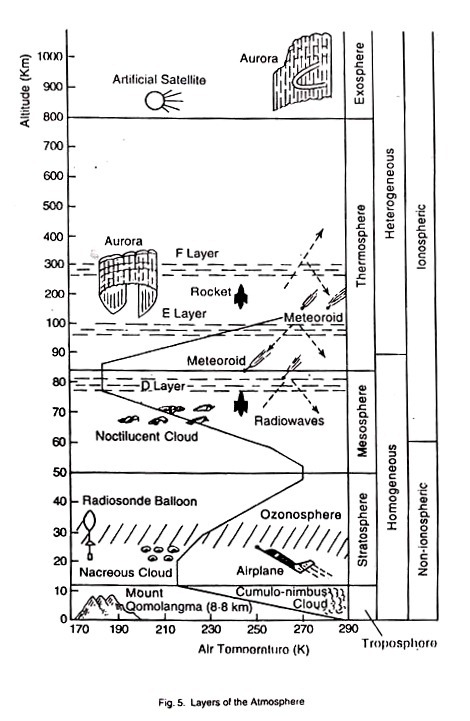This article throws light upon the five major layers of the atmosphere. The regions are: 1. Troposphere 2. Stratosphere 3. Mesosphere 4. Thermosphere 5. Exosphere.
Region # 1. Troposphere:
Almost 70% of the mass of the atmosphere is contained in this layer. It is more or less homogeneous in composition where there is no air pollution. The water content here also depends on the hydrological cycle. The troposphere is a region of turbulence. This is because of the global energy flow that arises from imbalances of heating and cooling rates between the equator and the poles.
The air is far from uniform, depending on density and temperature. In the troposphere, temperature decreases uniformly with increasing altitude. Near the ground level, the air is heated by radiation from the earth. At the top of the troposphere is the tropopause. This is the cold layer (-56°C) which marks temperature inversion, i.e. transition from negative to positive lapse rates.
Region # 2. Stratosphere:
This is the quiescent layer marked by a positive lapse rate. The temperature increases with increase in altitude. At the upper limit of the stratosphere it is -2°C. This region has the maximum concentration of Ozone. The gas absorbs ultraviolet radiation of the sun, raising the temperature and causing a positive lapse rate.
The importance of ozone lies in the fact that it acts as a protective shield for life on earth and from the detrimental effects of the scorching ultraviolet rays. It also supplies the heat for dividing the earth into a quiescent stratosphere and turbulent troposphere.
Since mixing in the stratosphere is very slow, the molecules or particles here persist for a long time. Therefore, once the pollutants are able to reach the stratosphere, they pose long-term global hazards, compared to their impact in the more dense troposphere.
Region # 3. Mesosphere:
This layer has been so named because of its situation in the middle of the five layers that is divided according to the thermal conditions of the atmosphere. The mesosphere stretches at altitudes between 50 and 80 km. It is also known as upper Troposphere since, due to the absence of ultraviolet absorbing species, temperature falls with increasing altitude, i.e. negative lapse rate prevails, basically similar to what happens in the troposphere.
During summer, the temperature of the mesopause over Arctic region can drop to as low as -100°C. The upper part of this layer remains colder while the lower part is warm. Due to this, there arises a connective motion of air. A significant feature of this layer is the formation of noctilucent cloud or an ice-cloud, formed by the deposition of a very small amount of water vapour on the nickel containing cosmic dust (by depositing, it means here the process by which water vapour turns into ice-crystals directly on the condensation nuclei).
The noctilucent cloud is silver-white and light blue in colour. It is cirrus-like in shape and appears over higher latitudes before sunset and disappears after sunset. A series of intense photochemical reactions, i.e. dissociations and recombination’s of different elements of the atmosphere, take place in the mesosphere under the action of the sun’s ultraviolet radiation.
In the layer below the mesosphere, the air is homogeneously mixed since both horizontal and vertical motions are present. For this reason, the atmosphere up to 90 km is termed as the homogeneous atmosphere.
Region # 4. Thermosphere:
This layer that extends from the mesopause up to about 800 km is noted for two striking features:
(a) Temperature rises with increasing altitude i.e. positive lapse rate prevails here. Satellite data shows that at 200 km temperature stays around 700°C, and at 300 km it exceeds 1,000°C. The high temperature results from the heat released by the dissociation of oxygen and nitrogen molecules and atoms. The dissociation is caused by the sun’s ultraviolet radiation with wavelengths shorter than 0.175 microns that can absorb the gases in the layer.
(b) The air is highly ionized. The gases present here, especially nitric oxide and oxygen, split into atoms and undergo ionization, following absorption of solar radiation in the far ultraviolet region. Over higher latitudes, the resplendent aurora appears in the Thermosphere. It is the outcome of the collision of some of the charged particles thrown out of the sun with the molecules and atoms of gases in the thermosphere, under the action of the earth’s magnetic field.
Region # 5. Exosphere:
This is the outermost layer of the atmosphere, and also the transition zone between the earth’s atmosphere and interplanetary space. The air is inconceivably thin and almost completely ionized. It consists of helium and hydrogen, the lightest constituents of air.
Basing on its electric properties, the atmosphere can be divided into two layers:
(a) The non-ionosphere is the section of the atmosphere up to 60 km. Here, the constituents remain in neutral state.
(b) The Ionosphere is the section of the atmosphere between 60 and 2,000 km. The ultraviolet radiation from the sun ionizes the air and produces ions and free electrons. The air thus becomes a mixture of charged particles and non-ionized neutral particles. These free electrons act as mirror and reflect certain types of radio-waves.

